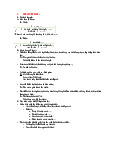





Preview text:
IELTS READING MATCHING HEADINGS
Ex 1: Skim the text and write one sentence saying what it is about.
Ex 2: Skim the paragraphs and answer the following questions
Ex 3: Which of these is the best title for the passage?
A. Solar power turns darkness to light in Zimbabwe
B. Ambitious project curtails land degradation
C. UNDP invests $7 million in Zimbabwe
D. Shamva’s farmers share solar power systems.
Ex 4: Read the paragraph below and decide which of these headings best suits
this paragraph, state your reason.
Ex 5: The Reading Passage has 4 paragraphs, A-D
Choose the correct heading for each paragraph from the list of headings below
Tea and the Industrial Revolution
A Cambridge professor says that a change in drinking habits was the reason for the Industrial
Revolution in Britain. Anjana Abuja reports
A. Alan Macfarlane, professor of anthropological science at King’s College, Cambridge, has,
like other historians, spent decades wrestling with the enigma of the Industrial Revolution.
Why did this particular Big Bang – the world changing birth of industry – happen in Britain?
And why did it strike at the end of the 18th century?
B. Macfarlane compares the puzzle to a combination lock. ‘There are about 20 different
factors and all of them need to be present before the revolution can happen,’ he says. For
industry to take off, there needs to be the technology and power to drive factories, large
urban populations to provide cheap labour, easy transport to move goods around, an
affluent middle-class willing to buy mass-produces objects, a market-driven economy and
a political system that allows this to happen. While this was the case for England, other
nations, such as Japan, the Netherlands and France also met some of these criteria but
were not industrializing. ‘All these factors must have been necessary but not sufficien tto
cause the revolution,’ says Macfarlane. ‘After all, Holland had everything except coal,
while China also had many of these factors. Most historians are convinced there are one
or two missing factors that you need to open the lock.’
C. The missing factors, he proposes, are to be found in almost every kitchen cupboard. Tea
and beer, two of the nation’s favourite drinks, fueled the revolution. the antiseptic
properties of tannin, the active ingredient in tea, and of hops in beer – plus the fact that
both are made with boiled water – allowed urban communities to flourish at close
quarters without succumbing to water -borne diseases such as dysentery. The theory
sounds eccentric but once he starts to explain the detective work that went into his
deduction, the skepticism gives way to wary admiration. Macfarlane’s case has been
strengthened by support from notable quarters – Roy Porter, the distinguished medica l
historian, recently wrote a favourable appraisal of his research.
D. Macfarlane had wondered for a long time how the Industrial Revolution came about.
Historians had alighted on one interesting factor around the mid-18th century that
required explanation. Between about 1650 and 1740, the population in Britain was static.
But then there was a burst in population growth. Macfarlane says: ‘The infant mortality
rate halved in the space of 20 years, and this happened in both rural areas and cities, and
across all classes. People suggested four possible causes. Was there a sudden change in
the viruses and bacteria around? Unlikely. Was there a change in environmental
conditions? There were improvements in agriculture that wiped out malaria, but these
were small grains. Sanitation did not become widespread until the 19th century. The only
option left is food. But the height and weight statistics show a decline. So the food must
have got worse. Efforts to explain this sudden reduction in child deaths appeared to draw a blank.’ List of headings
i. The search for the reason for an increase in population
ii. The time and place of The Industrial Revolutio n
iii. The cases of Holland, France and China
iv. Comparisons with Japan lead to the answer
v. Two keys to Britain’s Industrial Revolution
vi. Industrialization and the fear of unemployment
vii. Conditions required for Industrial Revolution Ex 6:




